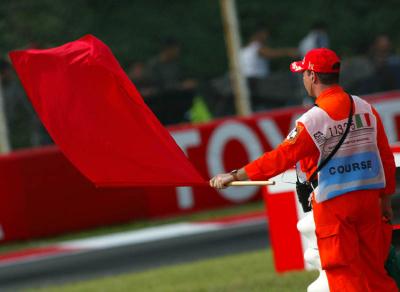What does that flag stand for?
In the V8 Supercar Championship the flags used on the racetrack are very important tools to communicate with drivers. At times they can be the eyes for the drivers.
Every circuit has numerous "flag points" at locations throughout the track with the main one being on the start/finish straight. Each flag point is generally manned by three people each focusing on the racing to ensure that the correct flags are displayed to the drivers in a timely manner.
Here, V8 Supercar team Orrcon Racing explain what each flag stands for...
In the V8 Supercar Championship the flags used on the racetrack are very important tools to communicate with drivers. At times they can be the eyes for the drivers.
Every circuit has numerous "flag points" at locations throughout the track with the main one being on the start/finish straight. Each flag point is generally manned by three people each focusing on the racing to ensure that the correct flags are displayed to the drivers in a timely manner.
Here, V8 Supercar team Orrcon Racing explain what each flag stands for...
Green flag:
Years ago this flag was used to start a race however this role has been replaced by a set of starting lights. The green flag is now used at every flag point to signal the race has resumed after a safety car period. It is also displayed at the flag point following the section of the track that may be under yellow flag (or caution conditions) to indicate that the track is now clear for racing.
National flag:
This flag is used to start the race if the starting lights are not functioning. The starting signal, using the flag, is given by lowering the flag from above the starter's head.
Yellow flag:
When displayed at a flag point this means the subsequent section of the track has a problem that requires that drivers slow down and not make any passes. Usually this is because a car has spun or crashed and is in a dangerous position. If a yellow flag is displayed with a white board that displays the letters "SC" it indicates that the full circuit is under yellow flag (or caution conditions) and the safety car will exit pit lane to pace the field at a reduced speed.
Yellow flag with red stripes:
This flag is commonly referred to as the "oil flag". This flag indicates to the drivers that there is a slippery surface ahead and may be debris on the circuit. Generally it is used when a car has lost oil or fluid on the circuit but is often used when a car has recently spun and dragged stones and kitty litter back onto the circuit.
Black flag:
This flag is displayed with a corresponding car number alongside at the flag point on the start/finish line. It is used to signify a penalty is to be applied for various offences with the most common being a driver exceeding the pit speed limit of 40 kmph or being the cause of an accident.
Once a driver is shown the black flag they must undertake a penalty by driving through pit lane without exceeding 40kmph. A driver cannot complete a pit stop while undertaking a black flag penalty.
Black flag with orange circle:
Commonly referred to as the "meatball" flag. It is used in conjunction with a board displaying a car number alongside to signify that the vehicle in question has a mechanical problems likely to endanger himself or others and means that he must stop at his pit on the next lap. When the mechanical problems have been rectified to the satisfaction of the Chief Scrutineer the car may rejoin the race.
Black and white flag divided diagonally:
This flag is used as a warning flag to a driver who has been reported for unsportsmanlike behaviour. This behaviour could include such things as curb hopping or unnecessarily changing lines to baulk a faster driver.
Blue flag:
Commonly referred to as the "passing" flag. If it is waved at a flag point the car behind is closely following and will possibly be looking to overtake shortly.
It is also shown to a driver that is about to be lapped and, when shown, the driver concerned must allow the following car to pass at the earliest opportunity.
Red flag:
When a red flag is displayed during a practice or qualifying session it signifies an immediate halt to the session due to a car or cars stopping in a dangerous position.
Under race conditions this flag is used when the track is blocked or has become undriveable due to inclement weather conditions. All cars are required to immediately return to pit lane at a significantly reduced speed, the lap in progress is discarded and restart for the balance of the laps will resume based on the order on the previously completed. If a race has completed over 75% of the intended amount of laps the race director has the option to declare the race complete.
Chequered flag
This black-and-white chequered flag is the most famous in racing, signifying the end of the session or race. At the end of a race, the first car to receive the chequered flag at the finish line is the winner.


![Johann Zarco, LCR, Honda RC213V, 2024 San Marino MotoGP, Misano, action [Gold & Goose]](https://cdn.crash.net/styles/thumbnail/s3/2024-09/GnG_1166323_HiRes.jpg?itok=vpgrU7Q4)

![Jack Miller, KTM Factory Racing, KTM RC16, San Marino MotoGP, Misano, action [Gold & Goose]](https://cdn.crash.net/styles/thumbnail/s3/2024-09/GnG_1167624_HiRes.jpg?itok=iz7mA4EQ)


![Fabio Quartararo, Monster Energy Yamaha Racing, Yamaha M1, 2024 MotoGP, Misano Test, action [Gold & Goose]](https://cdn.crash.net/styles/thumbnail/s3/2024-09/GnG_1168928_HiRes.jpg?itok=fcYSole_)
![Toprak Razgatlioglu, ROKiT BMW Motorrad, BMW M 1000 RR, Magny-Cours, WorldSBK [Gold & Goose]](https://cdn.crash.net/styles/thumbnail/s3/2024-09/GnG_1165133_HiRes.jpg?itok=GD5SVNVG)

